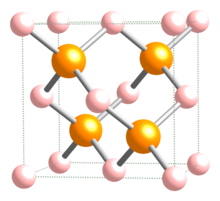Boron phosphide
Appearance

| |
| Identifiers | |
|---|---|
| ECHA InfoCard | 100.039.616 |
PubChem CID
|
|
CompTox Dashboard (EPA)
|
|
| Properties | |
| BP | |
| Molar mass | 41.7855 g/mol |
| Appearance | maroon powder |
| Density | 2.90 g/cm3 |
| Melting point | 1,100 °C (2,010 °F; 1,370 K) (decomposes) |
| Band gap | 2.1 eV (indirect, 300 K)[1] |
| Thermal conductivity | 4 W/(cm·K) (300 K) |
Refractive index (nD)
|
3.0 (0.63 µm)[1] |
| Structure | |
| Zinc blende | |
| F43m | |
| Tetrahedral | |
Except where otherwise noted, data are given for materials in their standard state (at 25 °C [77 °F], 100 kPa).
| |
Boron phosphide (BP) (also referred to as boron monophosphide, to distinguish it from boron subphosphide, B12P2) is a chemical compound of boron and phosphorus. It is a semiconductor.[2]
History
Crystals of boron phosphide were synthesized by Humphry Davy as early as in 1891.[3]
Appearance
Pure BP is almost transparent, n-type crystals are orange-red whereas p-type ones are dark red.[4]
Chemical properties
BP is not attacked by acids or boiling aqueous alkali water solutions. It is only attacked by molten alkalis.[4]
Physical properties
Some properties of BP are listed below:[1][4]
- lattice constant 0.45383 nm
- coefficient of thermal expansion 3.65×10−6 /°C (400 K)
- heat capacity CP ~ 0.8 J/(g·K) (300 K)
- Debye temperature = 985 K
- Bulk modulus 152 GPa
- relatively high microhardness of 32 GPa (100 g load).
- electron and hole mobilities of a few hundred cm2/(V·s) (up to 500 for holes at 300 K)
See also
References
- ^ a b c Madelung, O. (2004). Semiconductors: Data Handbook. Birkhäuser. pp. 84–86. ISBN 978-3-540-40488-0.
- ^ Popper, P.; Ingles, T. A. (1957). "Boron Phosphide, a III–V Compound of Zinc-Blende Structure". Nature. 179: 1075. doi:10.1038/1791075a0.
{{cite journal}}: CS1 maint: multiple names: authors list (link) - ^ Moissan, H. (1891). "Préparation et Propriétés des Phosphures de Bore". Comptes Rendus. 113: 726–729.
- ^ a b c Berger, L. I. (1996). Semiconductor Materials. CRC Press. p. 116. ISBN 978-0-8493-8912-2.
Further reading
- King, R. B., ed. (1999). Boron Chemistry at the Millennium. Elsevier Science & Technology. ISBN 0-444-72006-5.
- US patent 6831304, Takashi, U., "P-N Junction Type Boron Phosphide-Based Semiconductor Light-Emitting Device and Production Method thereof", issued 2004-12-14, assigned to Showa Denko
- Stone, B.; Hill, D. (1960). "Semiconducting Properties of Cubic Boron Phosphide". Physical Review Letters. 4 (6): 282–284. doi:10.1103/PhysRevLett.4.282.
{{cite journal}}: CS1 maint: multiple names: authors list (link)
